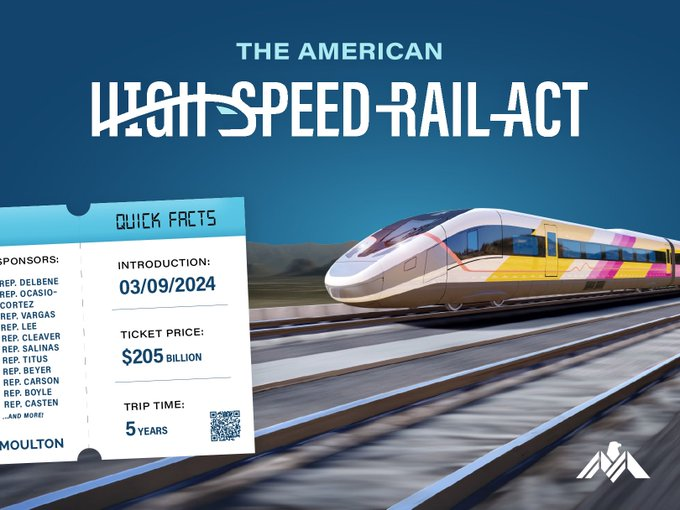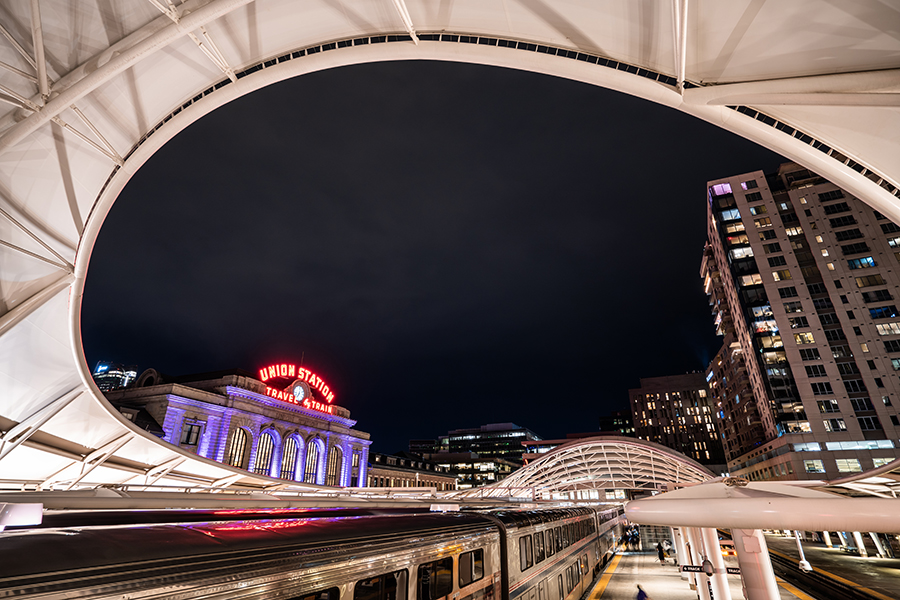The railroad Brightline today broke ground in Nevada on its new Brightline West project. Brightline will use trains traveling up to 200 miles per hour to cut the travel time between Las Vegas and Los Angeles in half. The company already operates successful trains...
A high-speed rail bill just dropped in Congress. Here’s why it’s a big deal.
A bill introduced in the House this week by Representatives Seth Moulton (D-MA) and Suzan DelBene (D-WA) would invest $41 billion annually in high-speed rail and “higher-speed rail” projects over five years, for a total investment of $205 billion.
For comparison, the federal government’s total infrastructure and transportation spending in 2023 was roughly $126 billion. About $56 billion (44 percent) of that spending went to highways; $29 billion went to air travel; and $28 billion (22 percent) went to railroads (which was roughly a $10 billion increase over spending on railroads in 2019).
Please ask Congress to support the American High-Speed Rail Act.
The American High-Speed Rail Act, which currently has more than 25 co-sponsors in the House, advances the prospects for a national network of high-quality passenger trains in several ways, including:
- It would authorize money for a specific program devoted to high-speed rail (Chapter 261 of Title 49), which hasn’t been funded since the Obama administration. This “high-speed rail assistance” program is distinct from other programs that fund railroad projects in the US (i.e., Crisi and federal-state partnerships). The $41 billion annually for HSR is roughly 150 percent of the total US spending on railroads in 2023. Nothing will incentivize high-speed rail projects like a federal program with robust funding specifically earmarked for HSR.
- It defines high-speed rail precisely and in line with global standards. The bill defines “higher-speed rail” as 110-186 mph and HSR as 186+ mph. It also caps funding for higher-speed projects at 20 percent.
- Along with the recently created Corridor ID program, it builds the momentum for a national network of fast, frequent, and affordable trains. Corridor ID is creating a pipeline of projects that are ready to be built when funding is available. In the initial round, 69 projects across 44 states were selected for inclusion, some of which are high-speed rail. Each receives $500,000 for planning work. In addition to creating a pipeline, the Corridor ID establishes a formal process for evaluating the priority and value of passenger-rail projects in the US.
- It proposes to develop comprehensive, performance-based safety regulations and standards for high-speed rail—which is key to reducing project costs and construction delays as projects move toward the construction phase. Regulatory roadblocks and inefficiencies are a key reason that transportation projects are so expensive in the US.
- It incentivizes freight-rail operators to sell or lease land on existing rights of way by exempting that profit from federal taxation—and providing a liability framework. As the Alliance has long argued, improving relations with Class I railroads—through better economic incentives—is key to building a national network of quality passenger-rail trains.
In September 2020, Moulton took part in an Alliance webinar and described his passion for bringing HSR to the US. “We are not living as well as we could—we’re not as productive a society, an economy—because we don’t have [good] transportation options,” he said. “And if we just simply leveled the playing field and gave high-speed rail a chance to compete against the other modes, then we’d see high-speed rail doing really well.”
The proposed program would evaluate projects based on metrics such as “equity, resilience, sustainability, economic development potential and climate,” and it would give priority to regions “not serviced by the aviation industry or where the government subsidizes aviation routes.”
In introducing the bill this week, Moulton said “we spend vast amounts of money subsidizing planes, which are delayed by weather, and roads, which are crumbling nationwide. We have the chance to think big and think differently. Let’s not waste the opportunity.”
We couldn’t agree more.
Read More:
Press Release: Moulton, DelBene Introduce the American High-Speed Rail Act
The Latest from HSRA
Our Latest Blog Posts
Check out the latest news, updates, and high speed rail insights from our blog!




